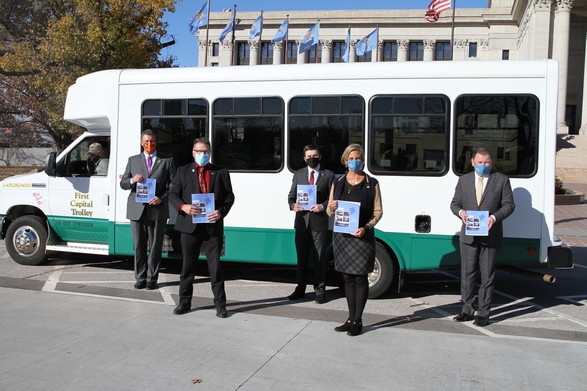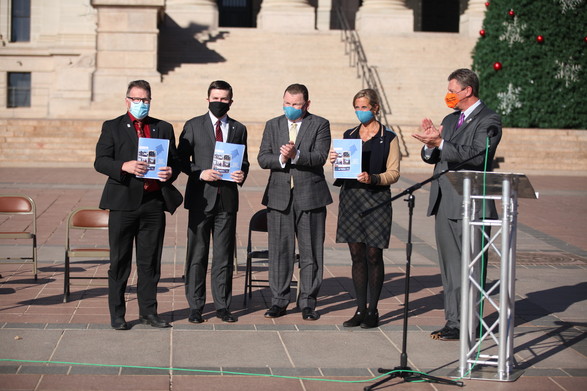(Pictured, from left, are Sen. Michael Bergstrom, Rep. Avery Frix, OTA Chief Executive Officer Mark Nestlen, Rep. Carol Bush and Secretary of Transportation and ODOT Executive Director Tim Gatz.)
Oklahoma’s first-ever transit plan created by the Oklahoma Department of Transportation and the Oklahoma Transit Association is now in the hands of legislative leaders.
More than a year in development, the plan was delivered on Thursday to leaders of the State Senate and House during a brief out-door presentation ceremony at the State Capitol.
The comprehensive, statewide plan outlines the goals, strategies, objectives and priorities to make Oklahoma a Top Ten state for public transit by 2040. Highlights include identification of the existing gap in funding for transit based on current and future projected needs, a strategic investment schedule outlining the best use of funds for the next 20 years and an in-depth examination of transit funding options used by peer states.
“Completion of the state’s first transit plan is a milestone achievement in moving Oklahoma toward becoming a Top Ten State for all modes of transportation, Gov. Kevin Stitt said. “Thanks to the input from transit providers and users, we now have a roadmap for modernizing transit services and ensuring mobility for all Oklahomans,”
“While ODOT has incorporated public transit in long-range planning efforts before, I’ve never seen it done to this level in my thirty years with the state,” Secretary of Transportation and ODOT Executive Director Tim Gatz said.
“Oklahoma’s transit system is currently near the bottom, but full implementation of this first ever statewide transit plan will elevate Oklahoma to a Top Ten state in public transit and ensure the mobility needs of all Oklahomans are met in a safe, economical and coordinated manner,” said OTA Chief Executive Officer Mark Nestlen.
The plan focuses on currently available transit services: public bus, van and streetcar. Goals over the next 20 years are meeting critical needs by 2025, expanding service by 2030, meeting the benchmark by 2035 and reaching mobility for all by 2040.
Creation of the Oklahoma Public Transit Policy Plan by ODOT and OTA was a key piece of House Bill 1365, which was enacted in 2019 to modernize public transportation by creating the Office of Mobility and Public Transit at ODOT and reforming administration of state and federal funding for transit programs by ODOT.
The transit plan was developed through stakeholder and public input from the transit industry and users. This included numerous meetings with a steering committee of transit leaders, site visits and interviews with transit operators and participation by partner agencies, government officials and advocates. The department also hosted several regional public meetings and administered an online public survey that received more than 2,000 responses.

(Pictured, from left, are Secretary of Transportation and ODOT Executive Director Tim Gatz, Sen. Michael Bergstrom, Rep. Avery Frix, Rep. Carol Bush and OTA Chief Executive Officer Mark Nestlen.)
“Public transit and mobility are very important not only to our metro areas, but also rural communities and tribal nations in Oklahoma,” Senate President Pro Tempore Greg Treat, R-Oklahoma City, said.
“The transit plan gives us the ability to address long-term needs and solutions in a comprehensive way,” Sen. Rob Standridge, R-Norman said. He is chairman of the Senate Transportation Committee and sponsored House Bill 1365 in the Senate.
“It’s important that all Oklahomans have the benefits of the mobility public transit provides,” said State Rep. Carol Bush, R-Tulsa, the principal author of HB 1365. “This not only gives people access to employment, healthcare and services but it improves our local and state economies.”
“This legislation helped us modernize our public transit policy as well as ensure better coordination between state agencies so that transportation dollars could be delivered more efficiently where they are needed,” said Rep. Avery Frix, R-Muskogee, who chairs the House Transportation Committee and was a co-author of the bill.
The Oklahoma Public Transit Policy Plan can be viewed at www.oktransitplan.org.







